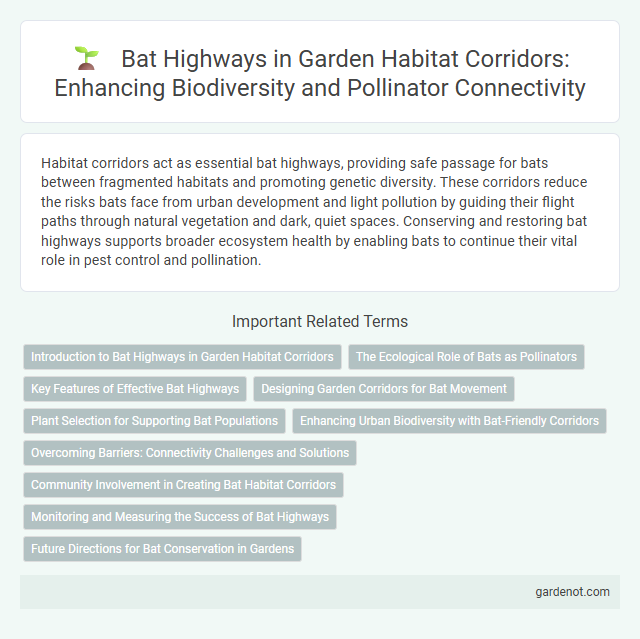Habitat corridors act as essential bat highways, providing safe passage for bats between fragmented habitats and promoting genetic diversity. These corridors reduce the risks bats face from urban development and light pollution by guiding their flight paths through natural vegetation and dark, quiet spaces. Conserving and restoring bat highways supports broader ecosystem health by enabling bats to continue their vital role in pest control and pollination.
Introduction to Bat Highways in Garden Habitat Corridors
Bat highways in garden habitat corridors serve as essential flight paths that connect fragmented green spaces, enabling bats to safely navigate urban environments while foraging and commuting. These purpose-built or naturally occurring linear features, such as hedgerows, tree lines, and watercourses, provide continuous cover essential for bat species sensitive to open or illuminated areas. Incorporating bat highways within urban planning enhances biodiversity by maintaining ecological connectivity and supporting bat populations critical for insect control and pollination.
The Ecological Role of Bats as Pollinators
Bats serve as vital pollinators in many ecosystems, particularly for nocturnal flowering plants, contributing to genetic diversity and plant reproduction. Their role in pollinating species such as agave and various fruit trees supports both natural habitats and agricultural industries. Habitat corridors like bat highways facilitate safe movement between fragmented landscapes, ensuring bats continue to fulfill their essential ecological functions.
Key Features of Effective Bat Highways
Effective bat highways incorporate linear vegetation structures such as hedgerows, tree lines, and riparian corridors that provide continuous, sheltered flight paths. These corridors connect important foraging sites with roosting locations, minimizing light pollution and avoiding physical barriers to enable safe navigation. Strategic placement near water sources and the inclusion of diverse insect habitats further enhance their functionality as critical wildlife passageways for bats.
Designing Garden Corridors for Bat Movement
Designing garden corridors for bat movement involves creating connected green spaces that facilitate safe navigation and foraging between habitats. Incorporating native plant species that attract insects enhances food availability, while minimizing artificial lighting reduces disturbance and disorientation for bats. Strategic placement of trees and shrubs forms continuous canopy cover, supporting the natural flight paths essential for bat highway functionality.
Plant Selection for Supporting Bat Populations
Plant selection for a bat highway prioritizes native species that produce abundant nectar, fruit, and insects, providing critical food sources for diverse bat populations. Incorporating flowering trees like Silky Oak (Grevillea robusta) and fruit-bearing plants such as Ficus species enhances foraging opportunities, while dense foliage offers essential roosting and navigation cover. Properly chosen vegetation supports bat biodiversity, aids in pest control, and strengthens ecological connectivity within habitat corridors.
Enhancing Urban Biodiversity with Bat-Friendly Corridors
Bat highways serve as vital habitat corridors that enhance urban biodiversity by connecting fragmented green spaces and allowing safe passage for bats. These corridors reduce habitat isolation, support pollination, and pest control services, contributing to healthier urban ecosystems. Implementing bat-friendly lighting and preserving natural vegetation along these pathways further optimize their effectiveness in sustaining bat populations.
Overcoming Barriers: Connectivity Challenges and Solutions
Bat highways face significant connectivity challenges due to urbanization and fragmented habitats disrupting natural flight paths. Effective solutions include installing green bridges, vegetation corridors, and specifically designed culverts that guide bats safely across roads and other obstacles. These habitat corridors restore flight continuity, reduce mortality rates, and support bat population stability by maintaining essential foraging and roosting routes.
Community Involvement in Creating Bat Habitat Corridors
Community involvement plays a crucial role in establishing effective bat highway habitat corridors by fostering local stewardship and awareness. Residents and volunteers participate in planting native vegetation and maintaining roosting sites that facilitate safe bat movement between feeding and breeding areas. Collaborative efforts between conservation organizations and communities enhance biodiversity and ensure long-term success of habitat connectivity for various bat species.
Monitoring and Measuring the Success of Bat Highways
Monitoring and measuring the success of bat highways involve tracking bat activity using ultrasonic detectors and infrared cameras to assess population movement and usage rates. Data collected on flight frequency, species diversity, and the timing of migrations provide critical insights into corridor effectiveness. Consistent monitoring enables adaptive management, ensuring habitat connectivity is maintained and bat conservation goals are met.
Future Directions for Bat Conservation in Gardens
Creating specialized bat highways in residential gardens enhances connectivity between fragmented habitats, supporting bat foraging and migration. Integrating native vegetation and artificial roosts within garden corridors increases biodiversity and provides essential resources for various bat species. Monitoring these corridors with ultrasonic detectors informs adaptive management strategies, optimizing conservation outcomes for urban bat populations.
Bat highway Infographic

 gardenot.com
gardenot.com